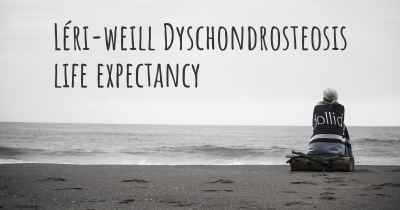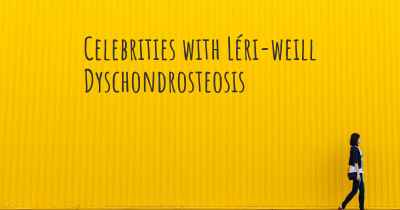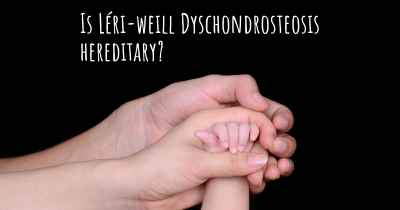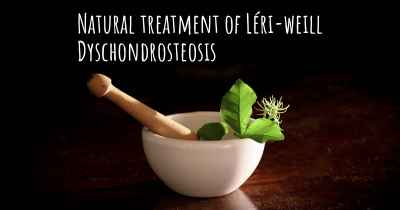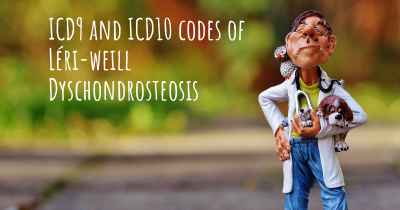Living with Léri-weill Dyschondrosteosis. How to live with Léri-weill Dyschondrosteosis?
Can you be happy living with Léri-weill Dyschondrosteosis? What do you have to do to be happy with Léri-weill Dyschondrosteosis? Living with Léri-weill Dyschondrosteosis can be difficult, but you have to fight to try to be happy. Have a look at things that other people have done to be happy with Léri-weill Dyschondrosteosis
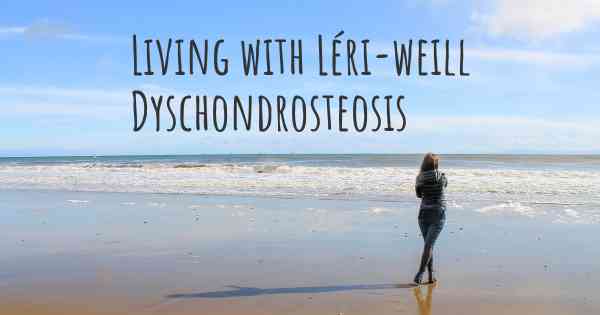
Living with Léri-Weill Dyschondrosteosis
Léri-Weill Dyschondrosteosis (LWD) is a rare genetic disorder that affects bone growth and development. It primarily affects the bones of the arms and legs, leading to short stature and skeletal abnormalities. Living with LWD can present unique challenges, but with proper management and support, individuals with this condition can lead fulfilling lives.
Medical Management
It is crucial for individuals with LWD to have regular medical care and follow a comprehensive treatment plan. This typically involves working closely with a team of healthcare professionals, including orthopedic specialists, geneticists, and physical therapists. The medical management of LWD may include:
- Regular check-ups: Routine visits to monitor growth, assess bone development, and address any complications or concerns.
- Physical therapy: Engaging in targeted exercises and therapies to improve muscle strength, flexibility, and overall mobility.
- Orthopedic interventions: In some cases, surgical procedures or orthopedic devices may be recommended to correct skeletal abnormalities or improve function.
- Hormone therapy: Growth hormone treatment may be considered to help promote linear growth in individuals with LWD who have growth hormone deficiency.
Psychosocial Support
Living with a rare genetic disorder like LWD can have emotional and psychological impacts. It is essential to seek psychosocial support to cope with these challenges. Here are some strategies that can help:
- Education and awareness: Learn as much as possible about LWD to better understand the condition and its implications. This knowledge can empower individuals and their families to make informed decisions and advocate for their needs.
- Support groups: Connect with others who have LWD or similar conditions through support groups or online communities. Sharing experiences, advice, and emotional support can be invaluable.
- Counseling: Consider individual or family counseling to address any emotional or psychological difficulties that may arise from living with LWD. A trained therapist can provide guidance and help develop coping strategies.
- Self-care: Prioritize self-care activities that promote overall well-being, such as engaging in hobbies, practicing relaxation techniques, and maintaining a healthy lifestyle.
Adaptive Strategies
Living with LWD may require some adaptive strategies to navigate daily life more comfortably. Here are a few suggestions:
- Assistive devices: Depending on individual needs, using assistive devices like orthopedic shoes, braces, or mobility aids can provide support and enhance mobility.
- Environmental modifications: Make necessary modifications to the living environment to ensure accessibility and safety. This may include installing handrails, ramps, or adjusting furniture heights.
- Advocacy: Be an advocate for yourself or your loved one with LWD. Educate others about the condition, raise awareness, and promote inclusivity and understanding.
- Education and employment: Explore educational and career opportunities that align with individual abilities and interests. It may be helpful to communicate with educational institutions or employers about any necessary accommodations.
Living a Full Life
While Léri-Weill Dyschondrosteosis may present challenges, it does not define an individual's entire life. It is important to focus on abilities, strengths, and personal goals. Here are some tips for living a full life with LWD:
- Embrace individuality: Celebrate uniqueness and focus on personal strengths and talents.
- Set realistic goals: Break down larger goals into smaller, achievable steps to maintain motivation and a sense of accomplishment.
- Stay connected: Cultivate meaningful relationships with family, friends, and the community. Social support can provide encouragement and a sense of belonging.
- Pursue interests: Engage in activities and hobbies that bring joy and fulfillment. This can help maintain a positive outlook and enhance overall well-being.
- Seek professional guidance: Work with career counselors or vocational experts who can provide guidance on suitable career paths and necessary accommodations.
Remember, each individual's experience with Léri-Weill Dyschondrosteosis is unique. It is essential to consult with healthcare professionals and develop a personalized approach to managing the condition. With the right support, adaptive strategies, and a positive mindset, individuals with LWD can lead meaningful and fulfilling lives.
Posted Oct 13, 2017 by Andrea 3910
Posted Aug 9, 2020 by Merisa 1500
